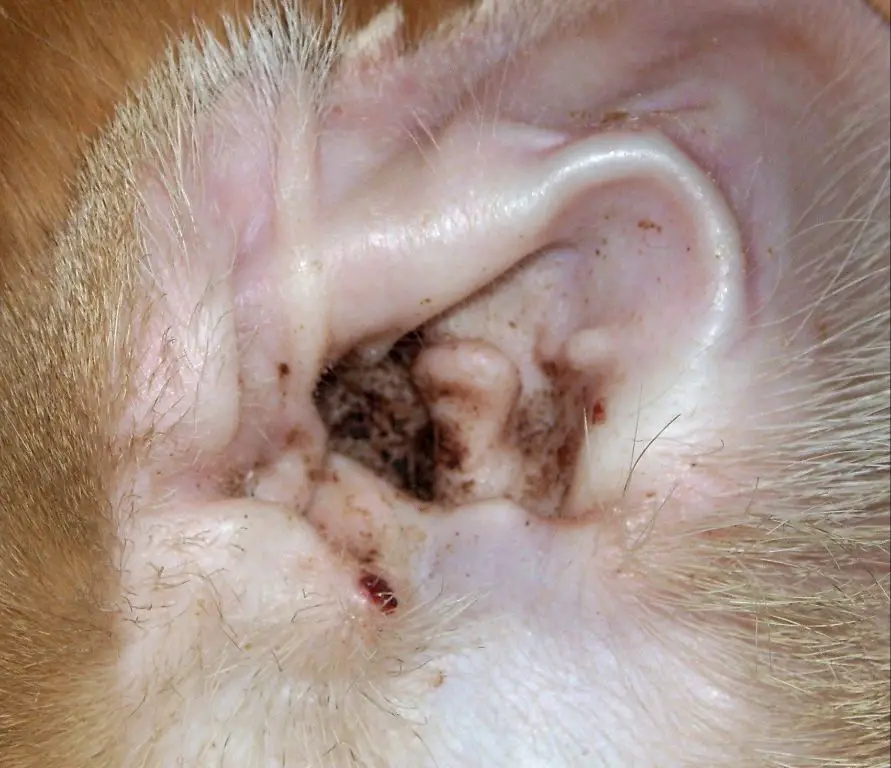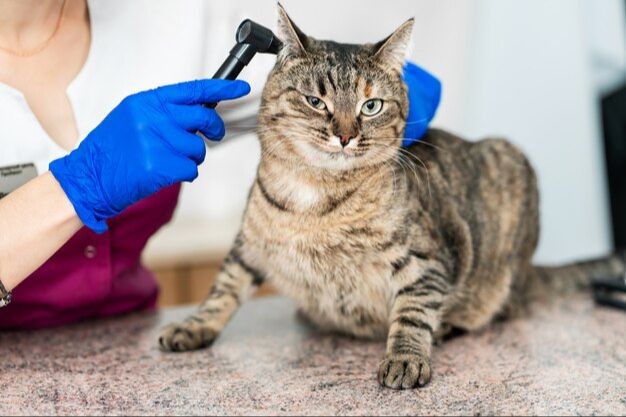What Are Ear Mites in Cats?
Ear mites, scientifically known as Otodectes cynotis, are tiny parasitic mites that live on the skin surface inside a cat’s ear canal. These mites feed on skin debris and oils inside the ear (Lefkaditis et al., 2009).
Cats typically get ear mites through direct contact with another infested animal. The mites can easily spread between cats in multi-cat homes or environments like shelters. Ear mites can also spread by contact with infested bedding or grooming tools (Fanelli, 2020).

Common symptoms of an ear mite infestation include excessive head shaking and scratching at the ears. You may also notice crusty discharge in or around the ear. Severe infestations can lead to ear hematomas, wounds, and secondary bacterial or fungal infections. If left untreated, ear mites can cause extreme irritation, pain, and even hearing loss (TodaysVeterinaryPractice.com, 2021).
The Dangers of Ear Mites
Ear mites can cause substantial discomfort and harm to cats if left untreated. The most common symptoms are intense itching, irritation, and inflammation of the ears. The mites feed on ear wax and oils inside the cat’s ear canal, causing extreme itchiness. Cats will violently scratch their ears trying to relieve the irritation, often creating wounds that can become infected.
As the infestation worsens, the inflammation and buildup of debris from the mites can lead to bacterial and yeast infections of the ear canal (otitis externa). These secondary infections are extremely painful for cats and require antibiotic treatment. According to Cornell University’s College of Veterinary Medicine, the irritation from ear mites can also prompt bacterial infections of the face and neck from the cat’s incessant scratching [1].
If ear mites are left untreated for a prolonged period, the inflammation and swelling can cause partial or total deafness. The debris and discharge from advanced ear mite infections can permanently damage the ear canal and eardrum. In addition to physical damage, chronic ear mite infestations can cause significant behavioral changes in cats, including lethargy, loss of balance, and irritability.
Diagnosing Ear Mites
There are a few different methods vets use to diagnose ear mites in cats:
Physical Exam – The first step is usually a thorough physical exam of the ears, looking for signs of irritation like redness, inflammation, dark crumbly discharge, and a foul odor. The vet will use an otoscope to look down the ear canal for the presence of mites (https://www.smalldoorvet.com/learning-center/medical/ear-mites-in-cats/).
Microscope Exam – Taking a swab or skin scraping sample from the ears allows the vet to examine it under a microscope. They will look for the presence of mites themselves as well as eggs and debris (https://www.matthews.carolinavet.com/site/pet-health-blog/2022/05/15/cat-ear-mites). This confirms the diagnosis.
Swab Test – A cotton swab can also be used to take a sample from the ear canal to test for mites. The sample is placed on a slide and examined under a microscope.
Treating Ear Mites
Once ear mites are diagnosed by a veterinarian, treatment typically involves medicated ear drops, oral medication, and cleaning/flushing the ears.

Medicated ear drops like Tresaderm or Vetoquinol’s Easotic are often prescribed. These contain active ingredients to kill mites and soothe inflammation caused by infestations. Drops are applied directly in the ear canal per the vet’s instructions, often daily for 1-2 weeks.
Oral medications containing ivermectin, selamectin, or moxidectin may also be prescribed to kill ear mites from the inside out (1). These are given once monthly for 2-3 months.
The veterinarian will also thoroughly flush the ears to remove debris. At home gentle cleaning with a cotton ball can help remove buildup while treating. However aggressive scrubbing and q-tips should be avoided as they may worsen irritation.
With diligent treatment following veterinary recommendations, medications and cleaning can successfully kill off ear mites and allow the ears to heal.
(1) https://www.vet.cornell.edu/departments-centers-and-institutes/cornell-feline-health-center/health-information/feline-health-topics/ear-mites-tiny-critters-can-pose-major-threat
Revolution for Cats
Revolution is a prescription topical medication used to protect cats from a variety of internal and external parasites. It contains the active ingredient selamectin and is applied topically to the skin on the back of the neck once a month.
Selamectin works by entering the bloodstream through the skin and from there, provides system-wide protection against heartworm disease, prevents flea infestations, and treats ear mites, roundworms, and hookworms in cats and kittens. It also prevents ticks like the American dog tick, Lone Star tick, and Black-Legged tick on cats.
In addition to ear mites, Revolution controls and prevents the following common cat parasites:
- Heartworms
- Fleas
- Roundworms
- Hookworms
- Ticks

The medication comes in small tubes that contain one single dose. The dosage is based on the cat’s body weight. Cats that weigh over 5 lbs can use the medication safely. Kittens as young as 6 weeks old can also be treated with Revolution following a veterinarian’s dosage recommendations [1].
Does Revolution Kill Ear Mites?
Yes, Revolution is highly effective at killing ear mites in cats. This is because Revolution contains the active ingredient selamectin, which has acaricidal properties that kill parasites like ear mites (Source). When applied topically as directed, selamectin is absorbed through the skin and enters the bloodstream, providing systemic protection against ear mites.
Studies show that a single topical dose of Revolution eliminated ear mites in approximately 98% of treated cats within 30 days (Source). The medication begins working within 6 hours after application and provides full protection against reinfestation for a month. Revolution is one of the most effective treatments for cat ear mites when used as directed by a veterinarian.
Therefore, Revolution’s active ingredient selamectin is highly efficacious at killing ear mites in cats. Just one dose provides almost immediate relief while protecting your cat from reinfestation for a full month.
Using Revolution to Treat Ear Mites
Revolution is a topical medication that can effectively kill ear mites in cats with just a single dose. It contains the active ingredient selamectin, which enters the bloodstream after application on the skin and provides parasite protection for a full month. One of the main benefits of Revolution for treating ear mites is that it only requires a one time application, unlike some other medications that require multiple doses.
Revolution is approved for use in kittens as young as 6 weeks old, weighing at least 2.8 pounds. It is also safe for adult cats of all ages. The single topical application is fast and easy to administer at home, without the stress of pills or injections. Revolution provides comprehensive protection by killing not just ear mites, but also treating concurrent infestations of fleas, heartworms, roundworms, and hookworms.

While Revolution treats the infestation itself with the single dose, pet owners will also want to thoroughly clean their cat’s ears to remove debris and buildup caused by the mites. Cats find ear mites extremely irritating, so by killing the parasites and cleaning out the ears, Revolution provides fast relief from constant scratching, head shaking, and discomfort.
Other Treatment Considerations
When treating for ear mites, it’s important to not just treat the cat, but also the home environment. Ear mites can survive for several days without a host, so all bedding and soft surfaces should be washed in hot water and vacuumed thoroughly. For multi-cat households, all cats should be treated at the same time even if they aren’t showing symptoms yet, as ear mites are highly contagious. Follow up exams with your veterinarian are also recommended after treatment is complete, to confirm the ear mites have been fully eliminated and no secondary infections have developed in the ear canal.
According to the FDA guidelines for Revolution, a second dose is recommended 30 days after initial administration to ensure all life stages of the ear mites are killed (1). Other treatment options your veterinarian may recommend alongside or in place of Revolution are ear flushes, antibiotic ear drops to treat secondary infections, and oral medication. Maintaining follow up exams is key to confirming success and providing relief for your cat.
Preventing Ear Mites
There are several steps cat owners can take to help prevent ear mites:
Keep cats indoors. Ear mites are highly contagious, so keeping your cat indoors reduces the risk of exposure. Cats that go outside are more likely to encounter stray cats or wildlife that may carry ear mites (1).
Regular vet exams. Your veterinarian can check for ear mites during annual wellness exams. Early detection makes treatment easier (2).
Clean bedding. Ear mites can live in carpets, bedding, and upholstery for about 3 weeks. Frequently wash your cat’s bedding and vacuum to remove eggs and minimize the spread of ear mites in your home (3).
(1) https://www.westchestervetmedcenter.com/site/blog/2022/05/15/ear-mites-cats
(2) https://www.vet.cornell.edu/departments-centers-and-institutes/cornell-feline-health-center/health-information/feline-health-topics/ear-mites-tiny-critters-can-pose-major-threat
(3) https://www.eastbayvetclinic.com/site/blog/2022/03/31/ear-mites-in-cats-causes-treatment-prevention
Providing Relief for Your Cat
Dealing with an ear mite infection can be uncomfortable for your cat, so proper cleaning and soothing treatments can provide relief and reduce the urge to scratch. According to veterinarians at Cornell Feline Health Center (https://www.vet.cornell.edu/departments-centers-and-institutes/cornell-feline-health-center/health-information/feline-health-topics/ear-mites-tiny-critters-can-pose-major-threat), gentle cleaning with a soft cloth or cotton ball can help remove excess wax and debris and allow medications to penetrate the ear canal more effectively. Take care not to push any material deeper into the ear canal.
Topical agents containing aloe, hydrocortisone, or other soothing ingredients can help relieve itching and inflammation. Your veterinarian may prescribe medicated drops to reduce swelling and discomfort. Keeping your cat’s ears clean and applying medications as directed will help minimize scratching and irritation. Soft cones may be used temporarily to prevent claw damage if scratching is severe.
With prompt treatment and proper care for your cat’s ears, ear mite infections can be managed effectively. Focus on gently cleaning and soothing irritated ears to provide relief while medications clear up the mites.
